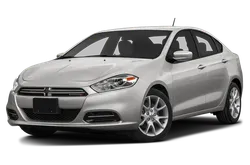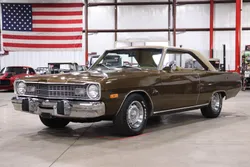

Dodge Dart - Generation 4 Facelift 1973 Overview
Explore the Dodge Dart and its Generation 4 Facelift of 1973, detailing specifications and historical significance, particularly in Portugal's automotive scene.
The Dodge Dart, an American automobile that has carved a niche in automotive history, reached a significant milestone with its fourth generation. Introduced in 1973, this facelift version of the Dart repr...
Technical Specifications
Select Version
Dimensions
Engine
Driving
Others
History and Features
Mycarro AI
Apr 27, 2025
The Dodge Dart, an American automobile that has carved a niche in automotive history, reached a significant milestone with its fourth generation. Introduced in 1973, this facelift version of the Dart represented Chrysler's endeavor to maintain relevance in a tight market while adapting to changing consumer preferences and regulations. The 1973 Dodge Dart facelift offered a blend of robust performance and updated design that continued to attract buyers from various demographics.
Design Changes and Features
The 1973 Dodge Dart facelift introduced a series of design changes that modernized its appearance while staying true to its roots. The most notable modification was the updated front fascia, which featured a broader grille and new, rectangular headlights that contributed to a more aggressive stance. The redesign also included larger bumpers that adhered to new federal safety regulations, an increasingly vital factor in the wake of the safety mandates that had taken effect for the industry.
In addition to changes in the front, the rear of the Dart also saw some significant updates. The taillights were enlarged and now featured a more horizontal design, which harmonized well with the overall aesthetic of the vehicle. Color options were expanded to keep up with consumer trends of the era, offering a lively palette ranging from pastel shades to bold, vibrant colors, catering to a diverse set of tastes.
Engine Options and Performance
The 1973 Dodge Dart continued to offer a variety of engine options that appealed to a range of drivers. The base model featured a 225 cubic inch (3.7 L) Slant-Six engine, which was both reliable and efficient, making it a preferred choice for those who prioritized fuel economy in their vehicles. For performance enthusiasts, a more powerful 318 cubic inch (5.2 L) V8 engine was also available, offering enhanced performance and acceleration.
During an era of increasing fuel prices and looming oil crises, the Dart's engine range and corresponding fuel efficiency became key selling points. While the Slant-Six offered decent power with commendable fuel economy, the V8's robust performance made it an attractive option for those seeking a spirited driving experience. With a choice between several transmissions, including a 3-speed automatic and a 4-speed manual, owners had the flexibility to select a configuration that best suited their driving style.
Interior Comfort and Innovation
Inside, the 1973 Dodge Dart facelift offered a comfortable cabin that emphasized both functionality and style. The dashboard was redesigned to be more driver-centric, featuring larger and more intuitive instrument clusters. The use of high-quality materials made for a more upscale feel, appealing to families and professionals alike.
One of the highlights of the Dart's interior during this generation was the available Rallye package, which incorporated sporty bucket seats, a sport steering wheel, and unique trim that enhanced the driver-focused ambiance. In an era where automotive comfort was becoming essential, the Dart made significant strides in offering features such as air conditioning, an AM/FM radio, and optional power accessories, making it a convenient choice for day-to-day use.
Legacy and Impact
The 1973 facelift of the Dodge Dart, while short-lived, was pivotal in keeping the model relevant during a challenging time for the automotive industry. Its combination of updated styling, diverse engine options, and comfortable interiors made it attractive to a wide audience. However, as consumer preferences began shifting, and competition in the compact car segment intensified, the Dart struggled to maintain its foothold.
Despite this, the fourth-generation Dart still holds a cherished place among classic car enthusiasts. Many models have been preserved and remain popular at car shows and vintage auto meets, serving as a testament to Dodge's engineering prowess and the model’s cultural significance. Today, the 1973 Dodge Dart is remembered not only for its design and performance but also for its role as a symbol of adaptability in a changing market.
Conclusion
Overall, the 1973 facelift of the Dodge Dart marked an important moment in the history of one of America's most enduring automotive nameplates. Its thoughtful updates, excellent range of engine choices, and comfortable interior set a standard for compact cars of its time. Despite its eventual decline, the Dodge Dart remains an iconic representation of 1970s automotive engineering and design, leaving a lasting impression that continues to resonate with car enthusiasts and collectors today.
